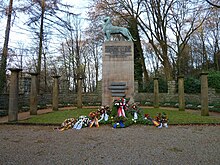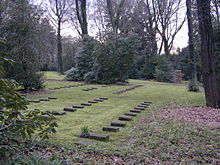Barmen Cemetery of Honor
The Barmen Cemetery of Honor is one of two cemeteries of honor in the city of Wuppertal . 1225 German and several foreign casualties from both world wars rest on it .
description
The cemetery of honor, located in the Barmer Forest south of Lönsstrasse on the Wuppertal's southern heights , was laid out in 1914 during the First World War for the fallen citizens of the then independent city of Barmen as the first in the Düsseldorf administrative region and was recommended to other cities for imitation. The area was made available by the Barmer Beautification Association . The facility was designed by Professor Hans Fischer from Barmen.
In 1921 the cemetery was expanded to include a burial ground for the twelve Barmen victims of the Kapp Putsch , which was destroyed during the Nazi era and rebuilt in 1946. A good 50 meters below, also on the northeast side of the cemetery, lies a single row of graves with non-German prisoners of war victims, mostly Russians, from and after the First World War.
The entrance area on Lönsstraße is designed by a flight of stairs , behind which a columned pergola welcomes the visitor . The war memorial stands in the middle of the pergola.
Monuments and grave sites
Several memorials and plaques can be found on the cemetery of honor, which was laid out in 1914:
War memorial
The most extensive monument is the war memorial, which stands in the middle of a pillared pergola made of 10 columns. The war memorial was unveiled on September 30, 1916 on the occasion of the first expansion of the cemetery, but it was still a long time to be erected. The base, which was transported to the cemetery on a wagon with 10 harnessed horses, bears a contemporary inscription by the author Will Vesper :
and the greatest need. Are we not
all ready for sacrifice and death?
One thing is burned in the sky
Everything may perish
Germany, our children and fatherland,
Germany must exist
A bronze lion sculpture by the sculptor Paul Wynand , symbolizing a lion from Barmer , sits enthroned on the base . This was initially carried out on a provisional basis, as the desired material “gilded bronze” was not available for reasons of war. Only after the end of the war did the city council of Barmens decide to complete the monument on July 6, 1922, and it was presented to the public on October 20, 1922 as the “ defiant symbol of the city ” and “a symbol of death-defying loyalty and bravery ”. After the Second World War, the inscription was added. The Wuppertal sculptor Fritz Bernuth made the four-line addition from bronze letters:
the world wars
1914–1918
1939–1945
Dying warrior
The Deutsche Bank memorial, also known as the “ Dying Warrior ”, was created by Walter Wolff in 1923 for the vestibule of the Deutsche Bank AG building in Elberfelder Königstrasse (today Friedrich-Ebert-Strasse ) to commemorate the 31 fallen employees. The illustration shows a suffering man lying on the ground, holding one wounded side and struggling to support himself with the other arm. The face with the eyes closed turns to the sky. An additional bronze plaque was installed on April 6, 1955 to commemorate the 19 fallen and 6 missing from the then Rheinisch-Westfälische Bank in World War II. When the old bank building was demolished in 1960/61 and replaced by a new building, the figure was placed on an open space in the upper part of the cemetery of honor at the suggestion of the director of the Von der Heydt Museum at the time, Günter Aust .
The war memorial in honor of the former prisoners of war
The war memorial in honor of the former prisoners of war on a part of the area attached to the Barmen Ehrenfriedhof was created by the Barmen Association of Former Prisoners of War and handed over to the city of Wuppertal on May 21, 1933. It consists of a memorial stone and seven graves of foreign prisoners of war (one Serb, three Belgians and three Russians) who died in the Barmen hospitals in the last days of the First World War and after burial in various Barmer cemeteries in 1933 with the participation of the Belgian Vice Consul from Cologne and Representatives of the authorities, the warrior associations and the churches were reburied there. The design of the tombstones is similar to that of the German fallen soldiers. The memorial stone, which was originally lined with two crosses, reads:
but love
rule the world!'
––
Godfather graves of
the
former prisoners of war
Barmen.
Memorial to those who fell in the Kapp Putsch
The memorial for those who died in the Kapp Putsch on a separate part of the cemetery was inaugurated on March 20, 1921. The grave sites are also optically matched to those of those who died in war, but only simply show names and dates of life. The associated memorial shows a sower at work under the bright sun, above him the sentence
when the man falls
March 1920
The sentence comes from the song Tord Foleson by the Norwegian Per Sivile , which was sung as a workers' battle song at the time and is often immortalized on the graves of the fallen in March 1920. The memorial was designed by Paul Kuhnle and recreated by Fritz Kuhnle based on the original after the supposed destruction by the National Socialists in 1946 . The sower symbolizes “ the victoriously striding proletariat ”, as Paul Sauerbrey (USPD) put it. In the early summer of 1980, the remains of the original were found on the cemetery grounds and placed on a terrace next to the war memorial.
Grave sites
The grave sites themselves are mostly made with grave inscriptions in unusually detailed form. Many grave sites have a gravestone on which a round or square bronze plate is attached, which was made by the Barmer entrepreneurs Otto Wirth and Emil Meurer in 1921 at a unit price of 120 Reichsmarks. There the name of the fallen, the military rank, the type of weapon , the place of birth, the date of birth, the unit , the place of the wounding and the place of the death and the date of death are noted.
See also
literature
- Bettina Tewes: Wuppertal cemeteries. Wartberg, Gudensberg-Gleichen 2006, ISBN 3-8313-1619-8 , pp. 58-73.
Web links
Individual evidence
- ↑ a b c d e f Ruth Meyer-Kahrweg : Monuments, fountains and sculptures in Wuppertal (main volume) Born, Wuppertal, 1991, ISBN 3-87093-057-8 .
- ↑ a b c Ehrenfriedhof Barmen on denkmal-wuppertal.de (accessed on December 4, 2013)
- ↑ Dying Warrior on denkmal-wuppertal.de (accessed on December 4, 2013)
- ↑ Prisoner of War Memorial at denkmal-wuppertal.de (accessed on December 4, 2013)
- ↑ Wuppertal-Barmen: Memorial for the March Fighters 1920 ( Memento of the original from December 19, 2013 in the Internet Archive ) Info: The archive link was inserted automatically and not yet checked. Please check the original and archive link according to the instructions and then remove this notice. , from deutsche-revolution.de
- ↑ Kapp Putsches Monument on denkmal-wuppertal.de (accessed on December 4, 2013)
Coordinates: 51 ° 15 ′ 36 " N , 7 ° 12 ′ 28" E

